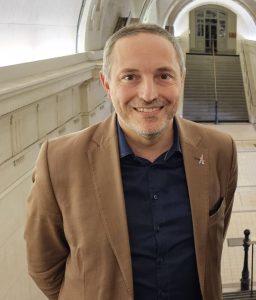Message from the President
Welcome to the website of the Neuengamme association, a historical resource
Whether you are family members of deportees who passed through the Neuengamme concentration camp, friends wishing to honor the memory of those deportees and their experiences, members of the Neuengamme association or simply visitors interested in history—particularly the history of Nazi concentration camps—you are warmly welcomed to the website of the Neuengamme association and its Kommandos.
This site is constantly evolving, and we will soon be integrating modern features, such as the ability to pay for orders online or access several of our archives.
For now, we have made every effort to include as much information and as many testimonies as possible to provide a detailed understanding of the deportees’ experiences at Neuengamme. We aim to regularly add new testimonies, so feel free to revisit our site often.
We are also continuing to update the “Memorial,” an important database of over 9,700 French deportees at Neuengamme, which includes key information about their journeys. This database has been accessible through our site since 2020. The Memorial is the result of a long effort, initiated more than 30 years ago by survivors and continued by a group of descendants. We are working to provide access to even more information about the deportees listed.
Soon, we will also introduce a new Memorial documenting the “personality-hostages” at Neuengamme, followed by a third Memorial focusing on women deported to Neuengamme’s Kommandos. If you have any information that could help us complete these Memorials, please do not hesitate to share it with us.
I hope this site will help you discover—or rediscover—this lesser-known camp of the Nazi concentration system and that you will find the information you are seeking.
Who knows… I also hope that reading this site may inspire some of you to contact us, join the Amicale, or take on new responsibilities if you are already members.
In these times when extremism is resurging in France, Europe, and around the world, and as the last surviving deportees able to testify about their experiences are disappearing, I am convinced that our association—and all memory associations—are more essential than ever. They remind us of the lessons of history and ensure we never forget. However, this mission requires all of us.
Brief History of the Neuengamme Concentration Camp
At the end of 1938, the Nazi regime established an external Kommando of the Sachsenhausen concentration camp in the village of Neuengamme, near Hamburg. A hundred deportees restored an abandoned brick factory. Starting in spring 1940, Himmler decided to turn it into a fully operational concentration camp, which quickly became the largest camp in northwestern Germany.
Between 1940 and 1945, more than 100,000 deportees from nearly 70 nationalities passed through Neuengamme.
However, few stayed in the main camp for long. The majority were sent, after quarantine, to one of Neuengamme’s labor Kommandos (satellite camps) to contribute to the German war economy. There were over 60 Kommandos for men and 24 for women, located across northern Germany near armament factories. These camps, hosting anywhere from a few deportees to several thousand, sealed the fate of many prisoners.
The daily life of Neuengamme’s deportees resembled that of the most notorious Nazi concentration camps: forced labor, insufficient food, dehumanization through endless roll calls and the replacement of names with matriculation numbers, summary executions, abuse of all kinds…
Mortality rates were extremely high, with nearly 90 deaths per day in December 1944 in the central camp or its Kommandos. French deportees to Neuengamme paid one of the heaviest tolls, with nearly two-thirds of the 11,600 French deportees (including over 700 women) not returning.
The camp is also infamous for its tragic evacuations in the final weeks of the war (“Death Marches”), where thousands perished in death camps like Bergen-Belsen, Sandbostel, and Wöbbelin. The tragedy at Gardelegen Farm saw over 1,000 deportees, mostly from Neuengamme, burned alive. Another horror occurred on May 3, 1945, in Lübeck Bay, where over 10,000 surviving deportees were crammed onto four ships by the SS. Mistakenly believing the ships were carrying SS troops to Norway, the Royal Air Force sank three of them, including the Cap Arcona and the Thielbek, killing nearly 7,000 deportees.
And yet, Neuengamme remains one of the most overlooked camps in the Nazi concentration system, likely because the SS evacuated it before the Allies’ arrival, meaning the camp was never “liberated.” Unlike other camps, no images of its liberation entered collective memory.
The Neuengamme association and its Kommandos: 1945 to Present
In August 1945, a group of deportees founded the Neuengamme association and its Kommandos, led by Marcel Prenant. Initially, the association aimed to support the families of those who did not return and assist survivors in need. It also sought to expose Nazi and Vichy collaborators’ barbarism and demand justice for the perpetrators.
The first issue of the Amicale’s newsletter, N’Oublions Jamais (Let Us Never Forget), was published in September 1945 and continues to be released quarterly to this day.
At the first Paris Congress on April 21-22, 1946, participants wrote the foundational “Pledge to Our Comrades,” promising the departed to “remain, until [their] death, faithful to [their] memory.”
Today, as I write these words, only two living deportees remain members of our Amicale. Nonetheless, families and friends continue to work tirelessly to ensure the atrocities of the past are never forgotten and to fight against extremist, nationalist, fascist, and racist ideologies. They strive to preserve the memory of the deportees’ suffering to protect democratic values.
Our efforts include organizing memory trips, maintaining the Memorial for French Deportees at Neuengamme, publishing books and reports, hosting conferences, and creating exhibitions. In March 2010, the Amicale adopted a “Manifesto,” which, like the “Pledge to Our Comrades,” reaffirms members’ commitment to this mission.
Join us if you wish to help continue this work. We need you! https://www.campneuengamme.org/adherer-aider/
President of the Neuengamme Association
Philippe COSNAY
